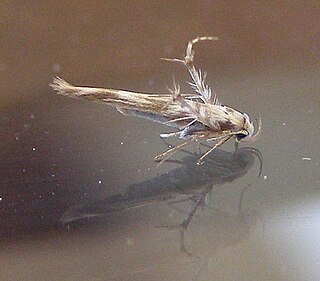Ebbe Schmidt Nielsen was a Danish entomologist influential in systematics and Lepidoptera research, and an early proponent of biodiversity informatics. The journal Invertebrate Systematics was established with significant contributions from Nielsen, and he assisted in the founding of the Global Biodiversity Information Facility (GBIF). Nielsen wrote several books, published over eighty scientific papers, and was highly regarded within the scientific community. Following his death, the GBIF organised the Ebbe Nielsen Prize in his memory, awarded annually to promising researchers in the field of biodiversity informatics. The moth Pollanisus nielseni is named after Nielsen.

Peucedanum is a genus of flowering plant in the carrot family, Apiaceae. Peucedanum boasts a global presence with diverse spread of morphological features. Peucedanum species are characterized by dorsally compressed mericarps, slightly prominent dorsal ribs, narrowly winged lateral ribs, and a broad commissure. However, the vast diversity of morphology, fruit forms, and phytochemical production makes classifying species in the Peucedanum challenging. Historically relevant in traditional medicine, Peucedanum's taxonomic complexity arises from its extensive diversity.

Palumbina is a genus of moths in the family Gelechiidae.
Asturodes is a genus of snout moths in the subfamily Spilomelinae of the family Crambidae. The genus is placed in the tribe Margaroniini.

Microcrambon is a monotypic moth genus of the family Crambidae described by Stanisław Błeszyński in 1970. Its single species, Microcrambon paphiellus, described by Achille Guenée in 1862, is endemic to Réunion and Seychelles.

Mazuca is a genus of moths of the family Noctuidae found in Sub-Saharan Africa. The genus was erected by Francis Walker in 1866.
Archaeopacha is a monotypic moth genus in the family Lasiocampidae. It was first described by Per Olof Christopher Aurivillius in 1925. Its only species, Archaeopacha obsoleta, was described in the same publication. It is found in the Democratic Republic of the Congo.
Abachausia is a genus of moths belonging to the family Pyralidae. It contains only one species Abachausia grisea, which is found in Namibia and South Africa.
The legal and cultural expectations for date and time representation vary between countries, and it is important to be aware of the forms of all-numeric calendar dates used in a particular country to know what date is intended.

Herpetogramma basalis is a species of moth in the family Crambidae. It is found on the Canary Islands and in Japan, China, Australia, Sri Lanka, India, Indonesia, La Réunion, South Africa, and Mali.
Scopula addictaria is a moth of the family Geometridae. It was described by Francis Walker in 1861. It is found in Sri Lanka.
Prionapteryx scitulellus is a moth in the family Crambidae described by Francis Walker in 1866. It is found in India, Sri Lanka and Kenya.
Patissa virginea is a moth in the family Crambidae. It was described by Philipp Christoph Zeller in 1863. It is found in the Democratic Republic of the Congo, Mozambique, South Africa, Taiwan, India and Sri Lanka.
Hypotacha raffaldii is a species of moth in the family Erebidae described by Emilio Berio in 1939. It is found in Eritrea, Oman, Saudi Arabia, Sudan and Yemen.
Compsoctena furciformis is a moth in the family Eriocottidae. It was described by Edward Meyrick in 1921. It is found in South Africa and Zimbabwe.
Dichomeris rhodophaea is a moth in the family Gelechiidae. It was described by Edward Meyrick in 1920. It is found in Tanzania.

Acacia amoena, commonly known as boomerang wattle, is a shrub belonging to the genus Acacia and the subgenus Phyllodineae that is native to parts of eastern Australia.

Warming stripes are data visualization graphics that use a series of coloured stripes chronologically ordered to visually portray long-term temperature trends. Warming stripes reflect a "minimalist" style, conceived to use colour alone to avoid technical distractions to intuitively convey global warming trends to non-scientists.

Mazuca strigicincta, the Pikachu moth, is a moth in the family Noctuidae found from Nigeria and Ghana down to northern Namibia and Mozambique.






